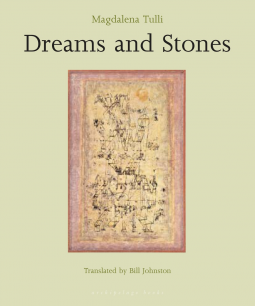
Dreams and Stones
by Magdalena Tulli
This title was previously available on NetGalley and is now archived.
Send NetGalley books directly to your Kindle or Kindle app
1
To read on a Kindle or Kindle app, please add kindle@netgalley.com as an approved email address to receive files in your Amazon account. Click here for step-by-step instructions.
2
Also find your Kindle email address within your Amazon account, and enter it here.
Pub Date Jun 07 2016 | Archive Date Apr 11 2016
Archipelago Books | Archipelago
Description
Advance Praise
Magdalena Tulli reveals herself to be the only true disciple of Bruno Schulz. —Jan Gondowicz, Nowe Ksiazki
Dreams and Stones, by the Polish writer Magdalena Tulli, is a postmodernist masterpiece of lyrical prose that defies generic definition and is rife with paradox and metaphor. —Kirsten Lodge, Slavic and East European Journal
A beautifully flowing translation. Johnston aptly captures the dreamy as well as the stark quality of the original. —Danuta Borchardt
Dreams and Stones is a startling, beautiful, powerful achievement. It calls the conventional genres of literature into question as its central image and metaphor, 'the tree of the world', grows, spreads and deepens. It does away with the persistent superstition of humanity's distinction from 'nature'. The originality of the writing is not lessened by representing a family tree that includes Michaud, Kafka, Calvino, and Saramago. It is a work to welcome and return to, and the translation is vibrant and graceful. —W.S. Merwin
Available Editions
| EDITION | Other Format |
| ISBN | 9780914671503 |
| PRICE | $16.00 (USD) |
Average rating from 14 members
Featured Reviews
 Ellen A, Educator
Ellen A, Educator
I had no idea what I was getting into when I began Dreams and Stones (by Magdalena Tulli). I had read comparisons to Invisible Cities and Bruno Schulz but I was still unprepared for the beauty of the dream that is this book.
At first I struggled to make sense of the book only to discover that when I let go of forcing sense upon it, the book began to make its own kind of sense. It is a prose poem describing the city that is the world and the countercity-the darkness and disorder we try to push away, and ignore that makes itself known by destroying the false order we impose upon life. There is the question of questions: hollow ones that destroy and genuine, authentic ones that support life.
This book makes a lot of sense in thinking about the world, what we hunger for, what we think is real or satisfying, but it goes beyond that. Like any poem, it pushes us beyond daytime reason into another nighttime world of dreams-and sometimes nightmares.
Once I read a few pages, I couldn't stop until I finished the whole work. It's like reading one long complex sentence that includes the world (although I'm grateful it is not one sentence!) or one thought that much be thought through to its end.
I thank NetGalley and Archipelego books for giving me the opportunity to read this work.
 Ilse A, Reviewer
Ilse A, Reviewer
“Prey to longing and doubt, every night the unquiet city of recollections releases dreams – enchanting adhesive shoots that seek support in silence and darkness.”
As a lover of modernist writing and aesthetics, I do not tend easily to fiction obviously labelled as postmodernist. However, I cannot remember ever having read anything as mind-blowing as this Polish post-communist author before. Quite unexpectedly, the ingenuity and beauty of the fragmented, surrealistic narrative and the bifurcating of time and place into multiple realities and possibilities, intrigued and enthralled me.
Plenty of Tulli’s imagery and metaphors are stunningly beautiful, though I am aware a great deal of their meaning didn’t unveil for me at a first reading. The density of her prose runs over the reader like a steamroller, and leaves the reader out of breath, too dazzled to seize all the meanings, connotations and layers in this collage dashed with paradoxes. Her prose is tinged with memorable sentences and passages:
”Where is that vast left-luggage office containing plush teddy bears that belonged to soldiers, the happy moments of abandoned women, the fortunes of bankrupts, the kisses of those run over by trams, the reflections of sunsets in windowpanes, finished melodies and eaten tarts?”
The focal point of Dreams and Stones is the (re)design and (re) building of the City, unnamed, but probably identifiable as Warsaw, taking up the few pointers Tulli drops (“It would seem unlikely that a name of such a city would include so many Ws and As at once,” echoing its Polish name Warzawa). The Warsaw indication helps to root the story in the real history of Poland and its capital, recalling Warzaw’s razing to the ground into ‘a sea of rubble’ by special Nazi troops mid-January 1945, the ultimate devastation of a city already almost wiped from the surface of the earth in the aftermath of the Ghetto Uprising in April 1943 and the Warsaw Uprising in August 1944. The ‘bricks for Warsaw’ campaign to build a New, Socialist Capital involved literally the whole nation, with donations and workers coming from all around Poland.
Tulli blows live into the famous socialist realist architectural sculpture adorning the edifices in Warsaw, movingly portraying the love and hope the workers put in the bas-reliefs decorating the façades, and in their new lives.
Her imaginary city however not wholly coincides with Warsaw, as a plethora of cities, depicted distortedly, but with familiar names like Paris, Petersburg, Milan, New York, Odessa, are all encompassed in the novel’s city, simultaneously, as mirages. And there are the perpetual past and “memory’s submerged theater”: “Past events leave traces in the memory like an ax chopping wood.”
Unlike every other novel I have read so far, this story doesn’t depend on any character at all. Even without individual characters - even not minimally sketched – to discern or sympathize with, the thoughts and dreams of the inhabitants of Tulli’s world accomplish to commit the reader emotionally and although represented in an abstract and generalized tone, go straight to the reader’s heart. Emotions inundate her world, like ours:
“Sorrow and joy in the city change just like the weather: slip in: p 46 no one knows where sorrow comes from in a city. It has no foundations; it is not built of bricks or screwed together from threaded pipes; it does not flow through electric cables nor is it brought by cargo trains. Sorrow drifts amongst the apartment buildings like a fine mist that the wind blows unevenly across the streets, squares and courtyard. Here and there a small point of joy appears and a zone of joy begins to expand in wedges down streets enveloped in sorrow; its advance parts pass over the roofs of buildings like an atmospheric front.”
The parable-like tale of the (re)building and life cycle of the socialist city, a living organism, in accordance with the new ideology , is a vehicle to touch on a multitude of philosophical and political themes worth exploring, themes which are presented dichotomically (tree versus machine, life versus death, real versus imaginary, cause versus effect, stones versus dreams, order versus chaos, city-counter-city). It seems to me that Tulli is playfully referring to and constantly shifting between dialectical idealism (Hegel) and dialectical materialism (Marx). Is the city ruled by the dreams of the inhabitants? Or is the material world ruling the minds? Is the world of ideas, the realm of dreams, responsible for, is it cause of, whatever order occurs in the material world? For Tulli, neither the world of substances, neither the world of ideas, is stable or permanent.
Does those dialecticisms breathe a certain nostalgia for the postwar communist time? Yes and no. As the city’s (re)buiding and (impossible) maintenance is suggestively paralleled with the rise and decay of Communism and its design of society, there is a certain flavor of nostalgia for the communist infancy stage, not for the further developments leading to the implosion of the system. Through the disordering of the city, Tulli describes poignantly the reaction of withdrawal from the communist ideals when the deceptive reality and deteriorating quality of life becomes visible. Losing hope, feeling like the wrong breed, an error in urban planning in this perfect city and society, the inhabitants come to see themselves like an ‘’interim species’, disheartened to save the collapsing system:
“That which one can bump into and hurt oneself on from a certain perspective is more real than the than the fleeting landscapes seen by a gaze turned in on the interior of the memory”.
This slender novel is a brilliant hymn to human imagination: “It is possible to imagine a city perfect in its entirety, a city that is the sum of all possibilities”. Tree or machine? Novel or prose poem? Postmodernist fiction or enchanting fairy-tale? It is totally up to you, reader. Do not take the ground under your feet for granted. Perhaps, as Tulli translated Calvino into Polish, Invisible cities would be a good next read.
I would like to thank NetGalley and Archipelago Books for giving me the opportunity to read this work and getting to know this wonderful writer.










